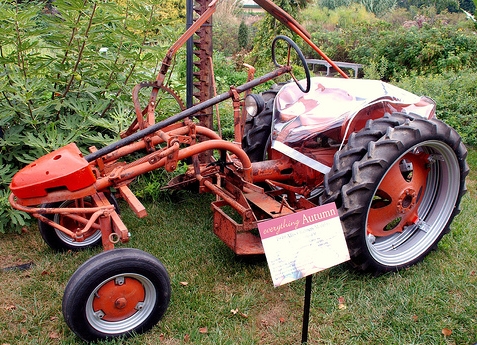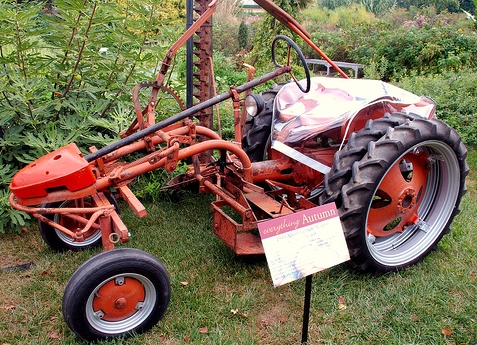Writer George Monbiot’s recent Peak Oil article entitled “If Nothing Else, Save Farming” included this comment:
There are no obvious barriers to the mass production of electric tractors and combine harvesters: the weight of the batteries and an electric vehicle’s low-end torque are both advantages for tractors.
I read this and immediately tweeted the question “Where are the electric tractors?”
Well, scientist-turned-farmer John Hewson has responded to Monbiot’s assertion with an explanation that lacks Monbiot’s, shall we say, sanguinary spirit:
[T]o anyone who has worked with farm machinery, especially on smaller and poorer farms, the idea of electric tractors will seem ridiculous. So far, electric traction has been developed only for transport, and most successfully in railway trains. The development of batteries and control systems has been directed at the needs of passenger cars, which do not have to pull heavy loads at low speeds for long periods.
Electric tractors do exist, but are light machines similar to ride-on lawn mowers, with power outputs of around 40kW. Typical farm tractors have outputs of 100kW-200kW, and no currently available batteries could provide anything like this amount of energy, or anything approaching the working life of a diesel engine.
The best lithium-ion electric car batteries and motors work at high voltages (500V for example). As an engineer, I would blench at the idea of maintaining a 100KW, 500V system in a damp and muddy farmyard, let alone carrying out running repairs in the middle of a 50-hectare field, in the rain.
As far as I know, electric traction for farm machines has not yet been even considered as an option. If it ever reaches the stage of production, it will be very expensive indeed – far beyond the budgets of even large farms.
But here’s the good news. Hewson appears to be, to a large extent, wrong! It didn’t take much digging for me to find an article singing the praises of electric tractors as perfectly suited for small-scale agriculture at least. It comes from a 2003 issue [PDF] of the Northeast Organic Farm Association’s Natural Farmer newsletter, republished here. Yes, it’s true, says the author, electric tractors are designed for mowing and light work. But people have also been converting diesel tractors to electric for real farm use with great results:
Ron Khosla, a small-scale organic farmer in New York state has converted an Allis Chalmers G to electric and told me “Our electric ‘G’ is absolutely the most important tractor on the farm. It has three times the power of the original ‘G’ which is huge and [has] enough battery life to do everything we need to on our diversified 8-acre farm… It’s totally silent. You can creep along MUCH more slowly than we could with gas. It’s silent. It doesn’t smell. It’s NO MAINTENANCE…
“It also has changed the way we operate the tractor. This is a psychological thing, but it’s real. With the gas tractor, we were less likely to stop in the middle of the row to adjust things, or clean a shoe, or whatever. With the [electric] tractor… somehow there is psychologically less inertia… And we stop ALL THE TIME to make final adjustments which has resulted in a better job. When you stop, you are stopped. No engine running. It’s just quiet and silent, no cloud of white smoke drifting over your head… nothing… Perfect silence. THIS is what sustainable farming is supposed to be about!”
His initial conversion was fairly simple, using a common series wound DC motor, golf cart controller, and regular lead-acid batteries. After learning the hard way how to care for the batteries, he has added meters, deep-cycle golf-cart batteries, and a better charger. He is planning to do a second conversion as part of SARE grant, which will include documenting the process via a web site.
 Allis Chalmers Model G tractorPhoto: cwalker71 via FlickrMaybe Hewson’s concern about muddy mid-field electric tractor maintenance is a bit misplaced. An important element in all this (and overlooked by Hewson) is this fact that weight and low torque are advantages for tractors. In practice that appears to mean that heavy, low-voltage “old-fashioned” lead acid batteries will do just fine. No need for high-end, high voltage and pricey lithium ion batteries after all. Anyway, it does indeed appear that a small farm can manage with an electric tractor.
Allis Chalmers Model G tractorPhoto: cwalker71 via FlickrMaybe Hewson’s concern about muddy mid-field electric tractor maintenance is a bit misplaced. An important element in all this (and overlooked by Hewson) is this fact that weight and low torque are advantages for tractors. In practice that appears to mean that heavy, low-voltage “old-fashioned” lead acid batteries will do just fine. No need for high-end, high voltage and pricey lithium ion batteries after all. Anyway, it does indeed appear that a small farm can manage with an electric tractor.
That said, even the Natural Farmer piece suggests that electric drivetrains aren’t [yet] suitable for industrial scale tractors or combine harvesters. And here we get to modern farming’s elephant in the field. Most of the “innovations” in industrial agriculture, from diesel tractors to pesticides to GMOs, have been about getting people (and animals) off the farm. But even the International Energy Agency, the group charged with estimating the world’s oil reserves (and the one recently accused of inflating these estimates on orders from nations like the U.S.) admits the possibility of oil production plateauing perhaps as early as 2020. In an environment of flat oil production, biodiesel will likely be prohibitively expensive as well — liquid fuel of any kind will be hard to come by. But the harvest will still need to come in — in a depopulated rural America, how will we manage that?
It may turn out that the only replacement for the workhorses of industrial ag like the large tractor and the combine harvester will be … workhorses — the four-legged kind. Wouldn’t that be something.
Granted, a return to real horsepower is unlikely to come to pass. But what may happen is that as those enormous thousand acre corporate farms become unmanageable, they get broken down into smaller holdings that more modestly-sized electric tractors can handle. Wouldn’t that be something.
Whatever we do, it will take creativity and commitment to come up with a replacement for diesel fuel on the farm — in Monbiot’s bit of anecdata, a farmer who’s been trying since the 70s has only managed a fuel-use reduction of 25 percent — and the stakes couldn’t be higher. Though perhaps we don’t have to reach quite as far back into time as the horse (or the human hand, for that matter) to save farming. According to the Natural Farmer article, farms in Latin America experimented in the late 19th century with stringing catenary, i.e. overhead wires, above fields to power tractors. Given that buses, not to mention high-speed trains, still run that way, maybe large tractors and combines could manage it. Old-time streetcar technology saving production agriculture? Well, that would be something, too.


